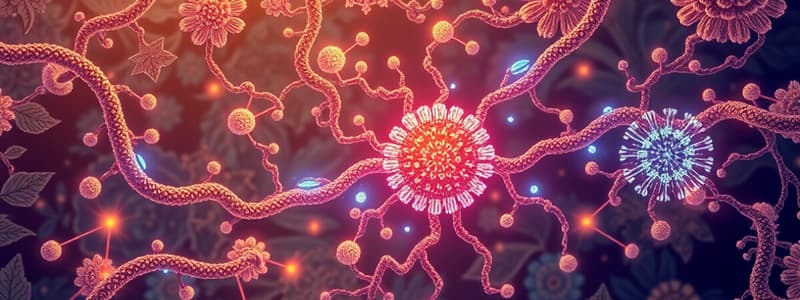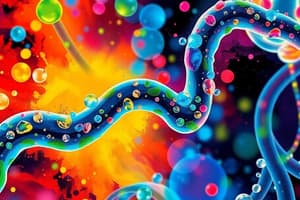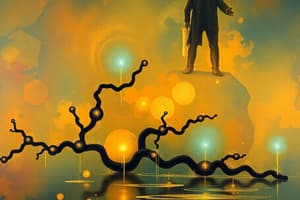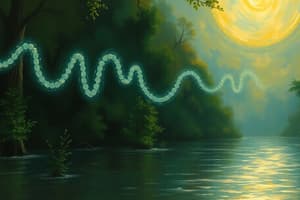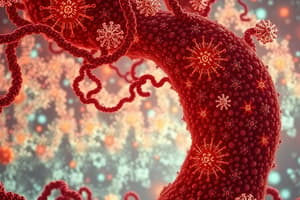Podcast
Questions and Answers
What is the primary structure of glycogen?
What is the primary structure of glycogen?
- Homopolysaccharide of α-D-glucose (correct)
- Heteropolysaccharide of β-D-glucose
- Heteropolysaccharide of α-D-glucose
- Homopolysaccharide of β-D-glucose
Glycogen is mainly stored in the liver and skeletal muscles for use during fasting periods.
Glycogen is mainly stored in the liver and skeletal muscles for use during fasting periods.
False (B)
What are the two main types of linkages found in glycogen?
What are the two main types of linkages found in glycogen?
α-(1,4) and α-(1,6)
Glycogenin is the ______ at the center of glycogen.
Glycogenin is the ______ at the center of glycogen.
During glycogen degradation, what is produced from the branching site?
During glycogen degradation, what is produced from the branching site?
The Pentose Phosphate Pathway only consists of oxidative reactions.
The Pentose Phosphate Pathway only consists of oxidative reactions.
Match the following products with their corresponding pathways:
Match the following products with their corresponding pathways:
Glycogen is a rapid energy resource primarily found in ______ and the ______.
Glycogen is a rapid energy resource primarily found in ______ and the ______.
How many ATP are generated from one NADH during the electron transport chain?
How many ATP are generated from one NADH during the electron transport chain?
FADH2 generates more ATP than NADH during oxidative phosphorylation.
FADH2 generates more ATP than NADH during oxidative phosphorylation.
What is the role of the Malate Aspartate Shuttle?
What is the role of the Malate Aspartate Shuttle?
Glycogen degradation is one of the primary sources of blood glucose along with ______ and ______.
Glycogen degradation is one of the primary sources of blood glucose along with ______ and ______.
Match the substrates with their corresponding ATP yield during glucose metabolism:
Match the substrates with their corresponding ATP yield during glucose metabolism:
Which enzyme is not involved in gluconeogenesis?
Which enzyme is not involved in gluconeogenesis?
Glycolysis occurs in the mitochondria.
Glycolysis occurs in the mitochondria.
What is the total ATP yield from one mole of glucose?
What is the total ATP yield from one mole of glucose?
1 mol of glucose undergoes glycolysis to produce ______ ATP and ______ NADH.
1 mol of glucose undergoes glycolysis to produce ______ ATP and ______ NADH.
Which of the following proves to be a slow response to a falling blood glucose level?
Which of the following proves to be a slow response to a falling blood glucose level?
What is the function of the TCA cycle?
What is the function of the TCA cycle?
Endergonic reactions have a negative ΔG value.
Endergonic reactions have a negative ΔG value.
What are the two stages of glycolysis?
What are the two stages of glycolysis?
The molecules that act as electron carriers in ATP synthesis are _____ and _____.
The molecules that act as electron carriers in ATP synthesis are _____ and _____.
Match the following terms with their correct descriptions:
Match the following terms with their correct descriptions:
What is produced during substrate-level phosphorylation in glycolysis?
What is produced during substrate-level phosphorylation in glycolysis?
ATP production occurs exclusively during oxidative phosphorylation.
ATP production occurs exclusively during oxidative phosphorylation.
What is the significance of the electron transport chain?
What is the significance of the electron transport chain?
The process of converting inactivated glucose to glucose 6-phosphate in glycolysis has a ΔG value of _____ kcal/mol.
The process of converting inactivated glucose to glucose 6-phosphate in glycolysis has a ΔG value of _____ kcal/mol.
Match the following processes with their descriptions:
Match the following processes with their descriptions:
What is a characteristic of exergonic reactions?
What is a characteristic of exergonic reactions?
Explain the role of NAD+ in glycolysis.
Explain the role of NAD+ in glycolysis.
The equation of ATP hydrolysis is ATP + H2O → ADP + _____ with a ΔG of _____ kcal/mol.
The equation of ATP hydrolysis is ATP + H2O → ADP + _____ with a ΔG of _____ kcal/mol.
Flashcards
Glycogen: What is it?
Glycogen: What is it?
A branched polymer of glucose, serving as a major form of glucose storage in animals. The linear portion of the chain is linked by -(1,4) glycosidic bonds, while branches are formed by -(1,6) glycosidic bonds. A protein core, glycogenin, is essential for glycogen synthesis.
Glycogen in Muscle: What's its purpose?
Glycogen in Muscle: What's its purpose?
Glycogen stored in skeletal muscle serves as a local energy source, providing glucose for muscle contraction. Muscle glycogen stores are quickly utilized during intense physical activity.
Glycogen in Liver: What's its purpose?
Glycogen in Liver: What's its purpose?
Glycogen stored in the liver plays a crucial role in maintaining blood glucose levels. It acts as a reservoir of glucose, releasing it into the bloodstream when needed.
Glycogen Synthesis: How does it work?
Glycogen Synthesis: How does it work?
Signup and view all the flashcards
Glycogen Degradation: How does it work?
Glycogen Degradation: How does it work?
Signup and view all the flashcards
Glycolysis: What is it?
Glycolysis: What is it?
Signup and view all the flashcards
Gluconeogenesis: What is it?
Gluconeogenesis: What is it?
Signup and view all the flashcards
Pentose Phosphate Pathway (PPP): What is it?
Pentose Phosphate Pathway (PPP): What is it?
Signup and view all the flashcards
Bioenergetics
Bioenergetics
Signup and view all the flashcards
Change in free energy (ΔG)
Change in free energy (ΔG)
Signup and view all the flashcards
Exergonic reaction
Exergonic reaction
Signup and view all the flashcards
Endergonic reaction
Endergonic reaction
Signup and view all the flashcards
Adenosine triphosphate (ATP)
Adenosine triphosphate (ATP)
Signup and view all the flashcards
Substrate-level phosphorylation
Substrate-level phosphorylation
Signup and view all the flashcards
Oxidative phosphorylation
Oxidative phosphorylation
Signup and view all the flashcards
Glycolysis
Glycolysis
Signup and view all the flashcards
Gluconeogenesis
Gluconeogenesis
Signup and view all the flashcards
Pentose phosphate pathway
Pentose phosphate pathway
Signup and view all the flashcards
Glycogenolysis
Glycogenolysis
Signup and view all the flashcards
Glycogenesis
Glycogenesis
Signup and view all the flashcards
Citric Acid Cycle (TCA cycle)
Citric Acid Cycle (TCA cycle)
Signup and view all the flashcards
Electron Transport Chain
Electron Transport Chain
Signup and view all the flashcards
What is the Electron Transport Chain (ETC)?
What is the Electron Transport Chain (ETC)?
Signup and view all the flashcards
Where does the ETC occur?
Where does the ETC occur?
Signup and view all the flashcards
What are the electron carriers in the ETC?
What are the electron carriers in the ETC?
Signup and view all the flashcards
How many protons are pumped per NADH and FADH2?
How many protons are pumped per NADH and FADH2?
Signup and view all the flashcards
What is the estimated ATP yield from one glucose molecule?
What is the estimated ATP yield from one glucose molecule?
Signup and view all the flashcards
What is the malate-aspartate shuttle?
What is the malate-aspartate shuttle?
Signup and view all the flashcards
What is the glycerol 3-phosphate shuttle?
What is the glycerol 3-phosphate shuttle?
Signup and view all the flashcards
What is glycogen?
What is glycogen?
Signup and view all the flashcards
What is gluconeogenesis?
What is gluconeogenesis?
Signup and view all the flashcards
What is the pentose phosphate pathway?
What is the pentose phosphate pathway?
Signup and view all the flashcards
Study Notes
Bioenergetics
- Bioenergetics is the transfer and utilization of energy in biological systems
- Bioenergetics predicts if a process is possible, kinetics measures the reaction rate.
- Enzymes cannot cause a reaction by themselves.
- They speed up the rate of reaction.
- An enzyme is a catalyst, it lowers the activation energy needed for a reaction.
Free Energy (G) and Energy Changes (ΔG)
- ΔG is a measure of the energy available for useful work.
- ΔG = Final Energy – Initial Energy (-ΔG)
- If ΔG is negative, the reaction is spontaneous (exergonic) and release energy
- If ΔG is positive, the reaction is non-spontaneous (endergonic) and requires energy
- Enzymes do not change the ΔG of a reaction, but they can lower the activation energy needed for a reaction
ATP Production
- ATP is Adenosine triphosphate, the main energy currency of cells
- ATP can be produced by two main ways:
- Substrate-level phosphorylation
- Oxidative phosphorylation
- Substrate-level phosphorylation: transferring a phosphate group to ADP from a high-energy molecule in the reaction.
- Oxidative phosphorylation: electrons are transferred through the electron transport chain, which makes a proton electrochemical gradient for ATP synthesis.
ATP Production (Oxidative Phosphorylation)
- NADH , FADH2 are electron carriers in cellular respiration. These molecules donate electrons to the electron transport chain to generate a proton gradient, which drives the synthesis of ATP.
Carbohydrate Metabolism
- The central role of carbohydrates in body metabolism is to store energy.
- Glucose is the primary source of energy in the body.
- Glycogenolysis is the breakdown of glycogen to glucose.
- Glycogenesis is the synthesis of glycogen from glucose.
- Glycolysis is the breakdown of glucose into pyruvate, generating ATP and NADH.
- Gluconeognesis is the synthesis of glucose from non-carbohydrate sources.
- Pentose phosphate pathway: An alternative pathway for glucose metabolism, which produces NADPH and ribose-5-phosphate. The ribose-5-phosphate is used to synthesis nucleotides.
- The pentose phosphate pathway is important for generating NADPH, an electron carrier used in reductive biosynthesis.
TCA Cycle
- Citric acid cycle, tricarboxylic acid cycle, Krebs cycle. All are synonymous.
- The main function of the TCA cycle is to harvest high-energy electrons from carbon fuels by producing ATP, NADH, and FADH2.
- Pyruvate should be transported to mitochondria before entering the TCA cycle.
- The irreversible synthesis of Acetyl-CoA from pyruvate links glycolysis and the TCA cycle.
Oxidative Phosphorylation and ETC
- The electron transport chain (ETC) is a series of protein complexes that transfer electrons from NADH and FADH2 to oxygen. This process generates a proton gradient across the mitochondrial inner membrane.
- ATP synthesis uses the proton gradient to generate ATP.
- NADH and FADH2 donate their electrons during oxidative phosphorylation, and this process generate ATP.
Electron Transport Chain
- Electrons from NADH and FADH2 are captured by the electron transport chain.
- Oxygen is reduced to water.
- ETC complexes pump H+ to outer membrane
- The positive charge out of the membrane generates a flow of H+ into the matrix, driving ATP synthesis.
Glycolysis – NAD+ Regeneration
- The net gain from glycolysis is 2 ATP and 2 NADH.
- Oxygen is required for oxidative phosphorylation to regenerate NAD+ from NADH.
- Without oxygen, fermentation allows glycolysis to continue. Fermentation regenerates NAD+ from NADH, allowing glycolysis to continue operating and producing ATP.
Pentose Phosphate Pathway
- The pentose phosphate pathway's main products are NADPH and ribose-5-phosphate.
- The oxidative reactions of the pentose phosphate convert glucose-6-phosphate to ribulose-5-phosphate, releasing CO2 and producing 2NADPH.
- Non-oxidative reactions help synthesize nucleotides and glycolysis intermediates.
Glycogen
- Glycogen is the storage form of glucose in animals
- Glycogen is a branched polysaccharide made of glucose molecules.
- Skeletal muscles and liver are major storage sites for glycogen, and are involved in maintaining blood glucose homeostasis.
- Glucose-1-phosphate is used for glycogen synthesis
- Glucose-1-phosphate is used in glycogen degradation.
Hormonal Regulation of Glycolysis
- Insulin and glucagon regulate glycolysis.
- Insulin promotes glycogen synthesis and glycolysis
- Glucagon stimulates glycogen breakdown and gluconeogenesis.
Transfer of Cytoplasmic NADH to Mitochondria
- The malate-aspartate shuttle and glycerol-3-phosphate shuttle transport cytoplasmic NADH into the mitochondria.
- These shuttles allow cytoplasmic NADH to contribute to ATP production in the mitochondria.
Glycogen Metabolism
- Glycogen synthesis requires UDP-glucose to incorporate into the glycogen chain
- Glycogen degradation cleaves glucose units from the non-reducing ends of the glycogen branches, generating glucose-1-phosphate.
- One glucose molecule can be removed from a branching point, yielding free glucose.
Energy Gained from 1 Mole Glucose (Oxidative State)
- The total ATP yield from 1 mole of glucose during cellular respiration is 36 or 38 ATP (depending on the shuttle used to transport NADH from the cytoplasm to the mitochondria).
Studying That Suits You
Use AI to generate personalized quizzes and flashcards to suit your learning preferences.
